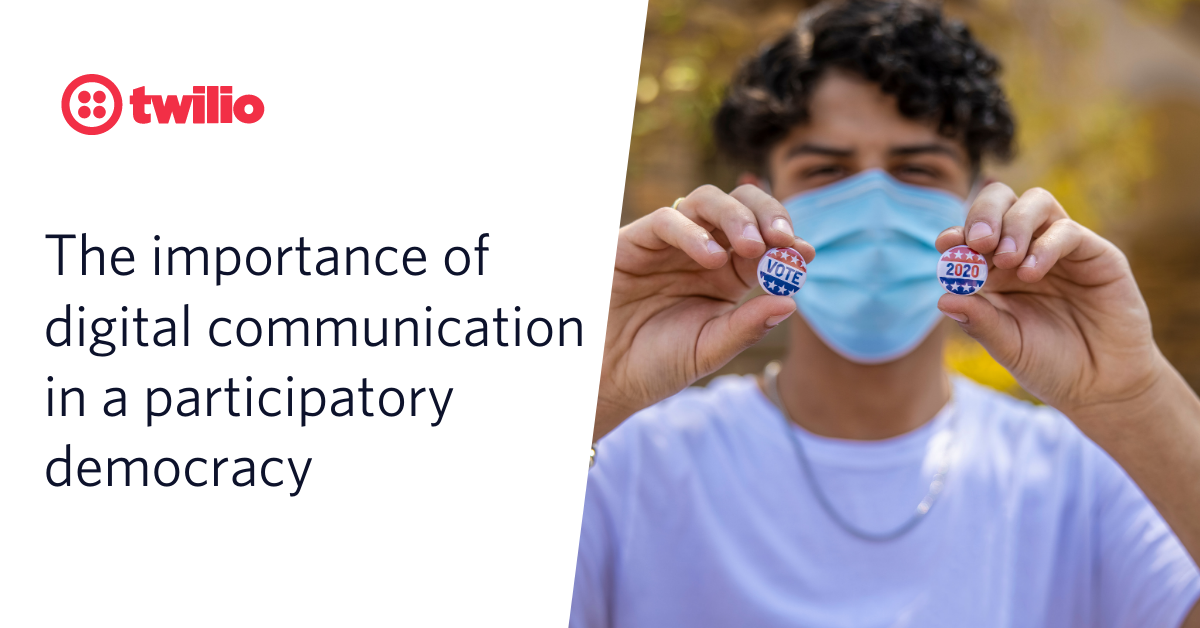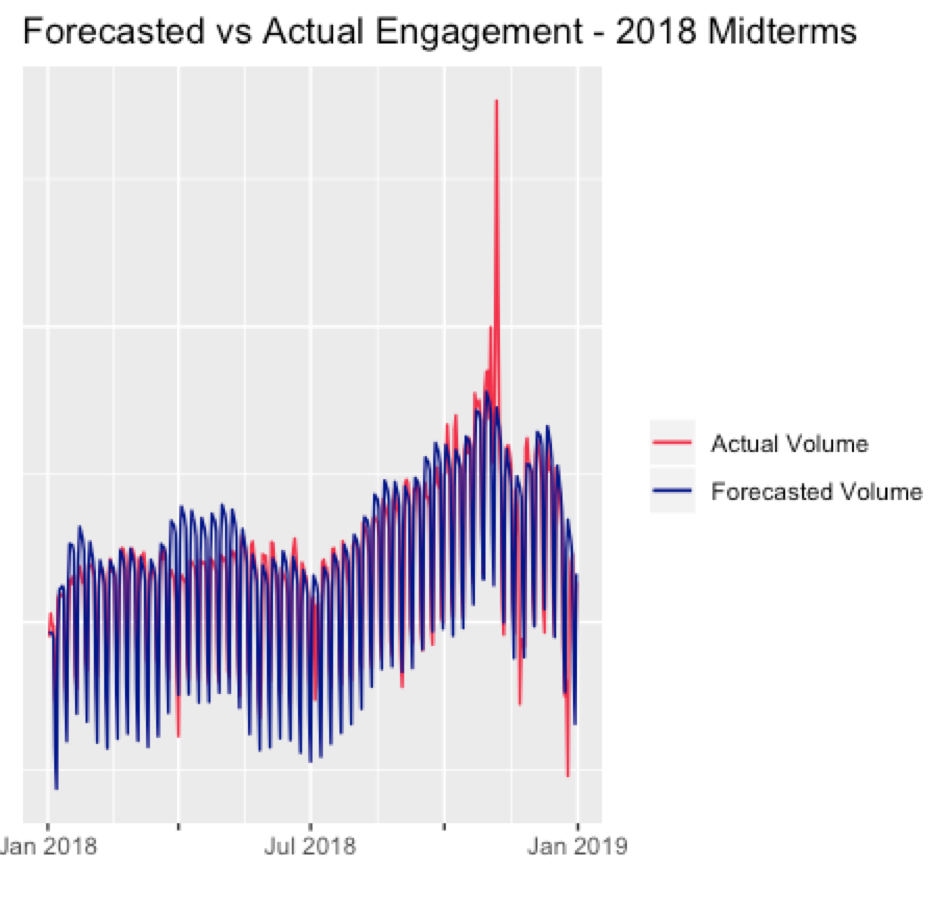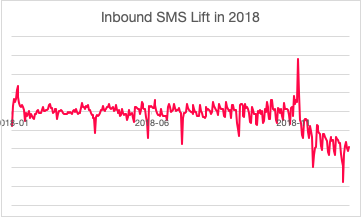Empowering voters with new and evolving digital communication strategies
Time to read:

Digital first. Digital acceleration. Digital transformation. All of these terms speak to the profound shift we’ve all experienced as more and more experiences—from buying a car to shopping for groceries—go digital.
Accelerated by COVID-19, this transformation has pushed businesses, brands, and nonprofits to evolve their digital engagement strategies to meet customers on the digital plane and provide new and innovative ways to engage.
Civic engagement organizations are no different, and in a United States election year, anyone with a mobile phone is a firsthand witness to those shifting digital strategies. From prompts and alerts on social media, to surveys and text messages delivered right to our phones, there are many new ways to register to vote, request an absentee ballot, learn about the issues, and engage in two-way conversations with volunteers working to get out the vote.
Ensuring integrity: Digital communications are critical in a participatory democracy
Across the U.S., nonpartisan civic engagement organizations are using digital communications across the voter experience, helping people to participate in their democracy and make their voices heard. From voter registration, to making a plan to vote, to navigating the changes in the voting process during the pandemic, organizations like DoSomething.org, VoteAmerica, and Democracy Works are using communications to help ensure that every eligible voter can cast their ballot.
Voter registration is core to participation, and DoSomething.org, the largest organization for young people and social change, is one of the leading nonprofits working to increase civic action among young people. Using online and SMS-based action campaigns, among other initiatives, DoSomething.org registered over 118,000 young people to vote in 2018.
In 2020, the organization has already exceeded its goal of 250,000 registrations, despite the challenges of COVID-19. Their fully digital program has again included SMS, email, and on-site messaging, as well as a focus on peer-to-peer student engagement by replicating the experience of running a voter registration drive in a young person’s community or school with their Online Voter Registration Drive (OVRD) tool powered by Rock the Vote, and amplified by partners like The National Association of Secondary School Principals and Rhode Island Department of Education.
2018 was a significant year for voter engagement: 53 percent of the citizen voting-age population voted in 2018, the highest midterm turnout in four decades. Among 18- to 29-year-olds, voter turnout went from 20 percent in 2014 to 36 percent in 2018, the largest percentage point increase for any age group—and representing a 79 percent relative increase.
Among 18- to 29-year-olds, voter turnout went from 20 percent in 2014 to 36 percent in 2018.
Higher voter engagement reflects the success that organizations like DoSomething.org have achieved in driving more socially active and civic-minded populations. The high turnout of voters also reflects these organizations’ commitment to providing informative digital communications, helping voters understand the process, get educated about candidates and issues, and navigate the complex electoral environment all the way to casting their vote.
See how Open Source Activism designs campaigns that scale and win
Here at Twilio, we’ve conducted data analysis to understand how constituents use digital communications during election season. Using historical data, we analyzed forecast v. actual inbound SMS volume around the 2018 midterms in the first week of November 2018—or the expected volume v. the actual volume of inbound inquiries. From voters, inbound inquiries could be questions like, “where is my polling station?” or “how can I make sure I’m registered?”
We found a 2000 percent increase in the actual volume of inbound messages against the forecast: people engaged with digital communications channels far more often than expected during the election week of the 2018 midterms. The uptick is strongly correlated to volume related to political activity (0.73 correlation).
In short, voters want to be more engaged and more informed. They’re sending more messages on digital communications channels and platforms, and generally sending messages related to understanding how they can be more engaged in democracy.


Figures from our analysis reflect the large spike (2000 percent lift) in actual inbound SMS volume v. forecasted volume in the November election week of the 2018 midterms. In Figure 1, the red spike demonstrates the jump in Actual Volume. In Figure 2, a more granular daily view shows the elevated levels of inbound SMS in the first week of November 2018 before the volume decreases back to tracking more with forecasted values.
We found a 2000 percent increase in the actual volume of inbound messages against the forecast: people engaged with digital communications channels far more often than expected during the election week of the 2018 midterms.
Another organization working to engage voters and help them cast their ballots is Democracy Works. Through their SMS app TurboVote, Democracy Works has helped more than 9 million people register, make a plan to vote, and remind people to cast their ballots on election day. The organization works to ensure all voters are able to cast a ballot, including those from populations historically underrepresented in the electorate.
Marginalized and underrepresented communities face unique hurdles when it comes to participating in elections. Through partnering with more than 200 campuses and 45 nonprofits across the country, Democracy Works is able to meet voters where they are at to help them register, make a plan to vote, and cast their ballots, whether in person or by mail.
While the majority of voters have cast ballots in person in previous elections, mail in voting has steadily increased in popularity over the past several decades. As recently as 1996, just 8 percent of votes were cast by mail, but by the 2016 general election 21 percent of voters mailed their ballots. With the 2020 election taking place during the COVID-19 pandemic, the move toward mail-in voting necessarily accelerated in many areas of the country. For people who are new to mail in voting, this means more information that needs to be accurately delivered: how to request a mail-in ballot, how to complete one, and how to track it after they’ve been submitted.
As recently as 1996, just 8 percent of votes were cast by mail, but by the 2016 general election 21 percent of voters mailed their ballots.
Nonprofit voter registration, voter turnout, and voter protection organization VoteAmerica has helped make mail-in voting a more widely available and utilized option for millions of voters in 2020. Nearly every state has an online system for registering to vote, but less than half have the same for requesting absentee ballots—and less than 5 percent of families have a printer or scanner for completing paper requests at home. To help people vote safely this election cycle, VoteAmerica built a Twilio powered SMS-based communications app that enables voters to complete, e-sign, and email or fax their absentee ballot request entirely by mobile phone.
Supporting digital engagement in our democracy
Organizations like Democracy Works, DoSomething.org, and VoteAmerica are using Twilio’s platform to increase voter registration and educate people on mail-in voting processes. The relatively new use of these digital communication strategies has and will continue to drive new forms of citizen participation—a goal we stand behind. Check your registration, learn more about mail-in ballots, and learn more about voting in your specific location by visiting VoteAmerica.com.
Related Posts
Related Resources
Twilio Docs
From APIs to SDKs to sample apps
API reference documentation, SDKs, helper libraries, quickstarts, and tutorials for your language and platform.
Resource Center
The latest ebooks, industry reports, and webinars
Learn from customer engagement experts to improve your own communication.
Ahoy
Twilio's developer community hub
Best practices, code samples, and inspiration to build communications and digital engagement experiences.


